Techniques Used
Assessment of the economic potential of lead-rich sulphide ore deposits follows techniques originally presented by Dr Brian Gulson. These techniques have been extended for use with lead-poor sulphide mineralisation e.g. gold occurrences and Cu-Ni sulphide occurrences. In all cases, the technique is most appropriate for prioritising a series of prospects and to screen out occurrences which do not appear to have formed from optimal fluid or magma flow situations. A database of known mineralisation in the exploration area will usually facilitate the assessment.
The technique is primarily based on lead isotopes although evidence from other isotope systems, especially Re-Os, when available, can play an important role. It is also suggested that the isotope techniques be implemented as part of a broader geochemical and geological survey.
A variety of isotope systems, including Pb, S, O, C and Sr may also be used to better understand the genesis of mineralisation without, necessarily, assessing the economic potential of the occurrence. Regional domains with appropriate isotope geochemical signatures may be identified in this way or specific instances of mineralisation may be studied.
Example Applications
Lead Isotope Assessment of Mineralisation |
|
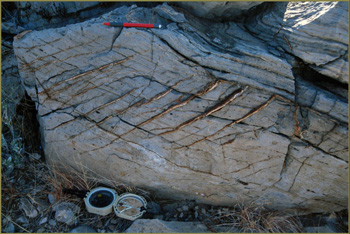 Lead (Pb) is usually an integral part of most metalliferous solutions and can thus be effectively utilised as a tracer of the processes leading to the concentration of minerals of economic interest. Analysis of the isotopic composition of Pb from areas of interest can provide important information on the economic potential of an exploration target and of the age of the mineralisation in some cases. |
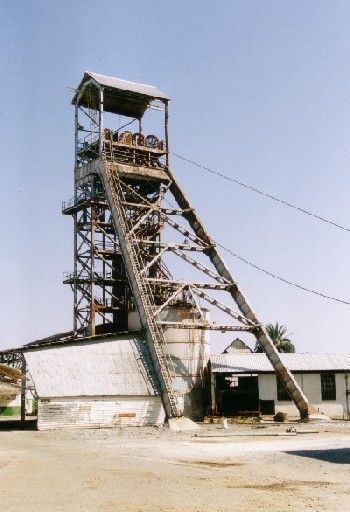 |
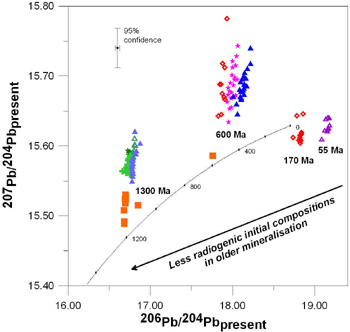 |
During solution, transport and deposition of metals, specific lead isotopic characteristics are imparted to the mineralisation. Generally these isotopic characteristics reflect:
|
| Subsequent events, such as granitic intrusions or metamorphism, may allow mixing of lead from the surrounding country rocks. This mixing could modify the signature of lead-poor mineralisation but should have little effect on major orebodies. The lead isotopic characteristics of a potential orebody thus reflect the process of radioactive decay within the source material or, for lead-poor mineralisation, in the ore itself. Consequently, specific ore types in a particular geological province have a characteristic lead isotopic signature which depends on the age of the mineralisation and the degree of enrichment of lead within the body. Furthermore, this signature is retained by the products of recent weathering of an orebody e.g. gossans (Gulson and Mizon, 1979) and may even be evident in local vegetation and groundwater, or as a halo around a hidden orebody. |
|
| An extensive database of Pb isotope results for different occurrences of mineralisation is of fundamental importance in interpreting newly discovered sulphide mineralisation. Such a database permits the easy comparison of the signature for new samples with known economic mineralisation either in the same area or of the same age and style. It is also possible to use lead isotopes during exploration if no database of target signatures is available. In this case, however, one needs to collect more samples of the prospect and/or also sample known economic mineralisation in the area. |
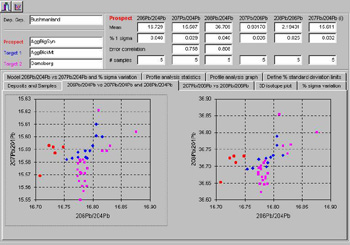 |
ApplicationIt is thus possible to measure Pb isotopes in an exploration prospect and to compare these with other known cases of mineralisation in the region of interest. Where the measured isotopic signature is similar to that of economically viable orebodies, continued investigation is warranted. In contrast, if the signature is dissimilar, continued investigation of the prospect may not be warranted. Figure 1 illustrates an application of lead isotopes in exploration. |
|
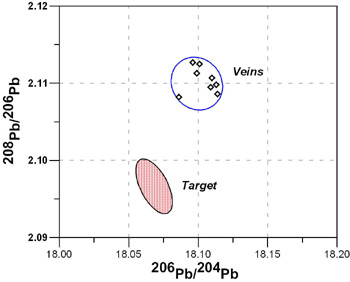 |
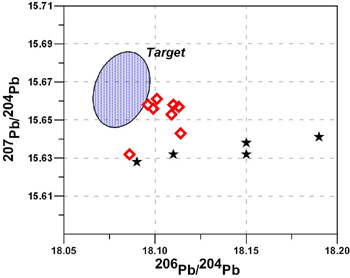 |
| For lead-rich prospects, the data should cluster tightly within analytical error of each other if the prospect is likely to be economic and will show considerable scatter if it is not. Lead-poor e.g. precious metal deposits should define a systematic linear scatter pattern where the variation can be directly related to the age of mineralisation. Non-economic lead-poor deposits will show considerable non-systematic scatter. Uranium-rich deposits should exhibit very radiogenic uranogenic lead isotope ratios. Most uranium-rich deposits have low Th/U ratios, hence the thorogenic lead isotope ratio is not likely to be enriched. The technique provides a very useful adjunct to other conventional assessment techniques during exploration. It is particularly cost-effective if applied prior to or early in a drilling programme. |
|
| In the situation illustrated in the lefthand figure (above), two types of mineralisation are known to exist in the area of interest. One form of mineralisation occurs in veins which are known to be sub-economic, whereas the other form of mineralisation is economically viable. Results for the prospect shown (black diamonds) resemble those of vein-type mineralisation, rather than the "target" and one would therefore recommend terminating exploration on this prospect. The righthand diagram shows a target field, defined from previous studies of economic mineralisation in the area of interest, together with isotopic results from two exploration targets. Although the isotopic signature of the prospect plotted as open diamonds does not match that of the target, the homogenous lead isotope signature suggests that this prospect requires continued evaluation. In contrast, the results of the other prospect (stars) are not consistent with the style of mineralisation sought and are also heterogeneous. |
|
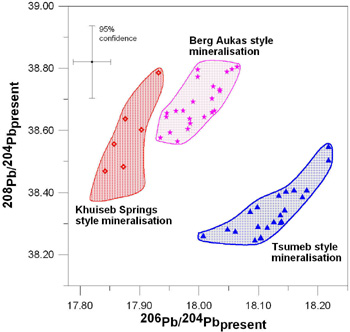 |
This graph illustrates a situation from Namibia in which the lead isotope signature of mineralisation at an exploration prospect (Khuiseb Springs) was compared with the signatures for sub-economic mineralisation (Berg Aukas) and economic mineralisation (Tsumeb). The Khuiseb Springs data did not match the known mineralisation styles in the Otavi region but was isotopically homogenous. The exploration company was advised to drill the prospect, leading to intersection of economic mineralisation and the creation of the Khuiseb Springs mine. |
| The isotopic variability within deposits may be illustrated as a percentage variation. In this case, the distinction between mineralisation which is assumed to be economic and that which is not is set by the analytical precision (green boundary in graph). Mineral occurrences plotting within the boundary are considered to warrant further exploration whereas those outside the boundary are not. | 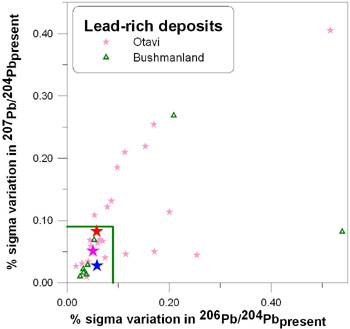 |
| A similar approach may be utilised for lead-poor mineralisation, such as gold and Ni-Cu-PGM, but here one also needs to correct for decay of uranium to lead since formation. The following two diagrams illustrate assessment of various gold deposits (left) and Ni-Cu sulphide occurrences (right). | |
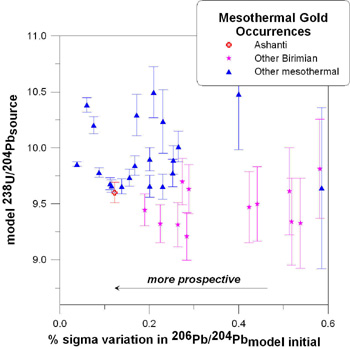 |
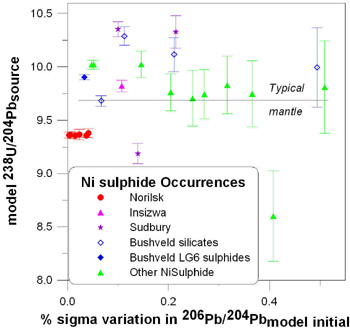 |
Material Required
For further information, contact Bruce Eglington |
|
Origin of Mineralisation in the Kumtor Gold Deposit, Kyrgyzstan |
|
 |
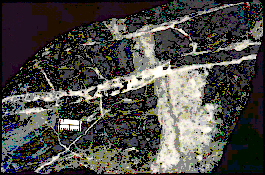 |
| Graduate students Sergey Ivanov and Albert Abeleira, in a project partly funded by Cameco, have examined the geology, structure, and fluid evolution of the giant Kumtor gold deposit in Kyrgyzstan. The veins consist of quartz, carbonate, hematite and pyrite, and the gold is associated with sulphides and tellurides. Stable isotope composition of the quartz veins give temperatures of about 300 degrees for the fluid and are consistent with generation of the fluid by dehydration of metamorphic rocks or degassing of coeval magmas in the middle crust. The complexity of the mineral textures make separation of minerals difficult, and further work will require micromilling to sample specific parts of mineral that grew at the same time as gold. For further information, contact Kevin Ansdell |
|


